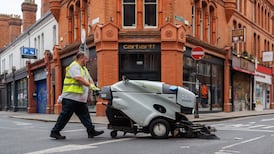AT the time of his appointment to the RUC in 1989, there was speculation that the then Mr Hugh Annesley would spend two or three years in Belfast to return to head the Metropolitan where he had spent most of his career.
He was the epitome of modern policing, a figure removed from the image of the traditional, tough and slightly dim "peeler".
His adeptness in diplomacy and public relations was soon evident in Belfast. Within a short time of his arrival, he appeared, with his officers, on the Falls Road, just before a highly charged Sinn Fein demonstration.
His comments to the media were not that remarkable. However the fact that an RUC Chief Constable was prepared to appear on the Falls was enough to attract the media attention away from the message of the demonstrators. It was Sir Hugh and not Mr Gerry Adams whose face appeared first on the television news that night.
He took over the RUC just as the republicans and loyalists were stepping up a sectarian war in the North which culminated in an obscene fortnight of violence at the end of October, 1994, with the Shankill and Greysteel massacres.
The main controversy during his period of office concerned the allegation that the security forces were, as a matter of course, supplying intelligence information on republicans to loyalist assassins.
He called in John Stevens whose investigation was extensive and actually resulted in the exposure and arrest of Brian Nelson, the Ulster Defence Associations (UDA) intelligence officer and, it emerged, a British army double agent.
More recently, the RUC has become embroiled in arguments with the Northern Ireland Police Authority, the board which appoints chief constables and oversees the non operation side of the force.
Importantly, Sir Hugh's appointment copper fastened the improvement in relations between RUC headquarters and the Garda Depot.
Relations between the top echelons in both forces were severely strained in the mid 1980s following a number of off the record briefings by the RUC criticising the Garda - in one instance suggesting the Garda was infiltrated by the IRA.
Tension was calmed on political direction from both governments and Sir Hugh inherited a much improved set of relations and established friendly links with the then Garda Commissioner, Mr Eugene Crowley, and the current Garda Commissioner, Mr Patrick Culligan.
Senior gardai were yesterday extremely complimentary of Sir Hugh. "He led the RUC through very difficult times and maintained extremely good contact. He ensured there was the highest level of co operation," said one senior officer.
The improvement in relations has developed to the extent that the two men tipped to take over each force, Deputy Chief Constable Ronnie Flanagan and Deputy Commissioner Pat Byrne, probably have the closest working relationship ever between officers of such rank.
Sir Hugh made it clear on his arrival that the fact that he was a Dubliner would help in relations with the Garda. His father worked with the confectioners, Willwoods, in Dublin. Hugh and his two brothers grew up in Foxrock and attended Avoca School, one of the schools incorporated in Newpark Comprehensive.
For reasons which he has yet to elaborate, he chose a policing career in the London Metropolitan. He joined in 1958 and five years later was chosen for the force's accelerated promotion scheme. He was made a chief inspector while still in his 20s.
He was appointed to the Special Patrol Group, formerly the Riot Squad. He rose to chief superintendent in the Met, before being appointed assistant chief constable of Sussex, returning to Scotland Yard as deputy assistant and then assistant commissioner in the late 1980s from which he moved to Belfast.









